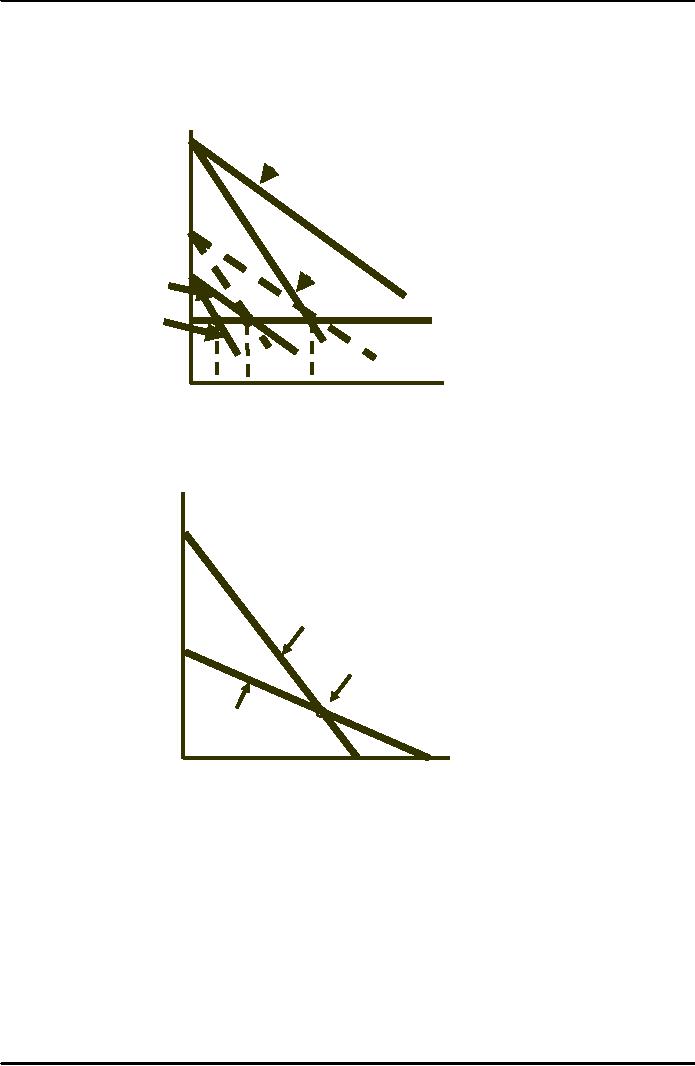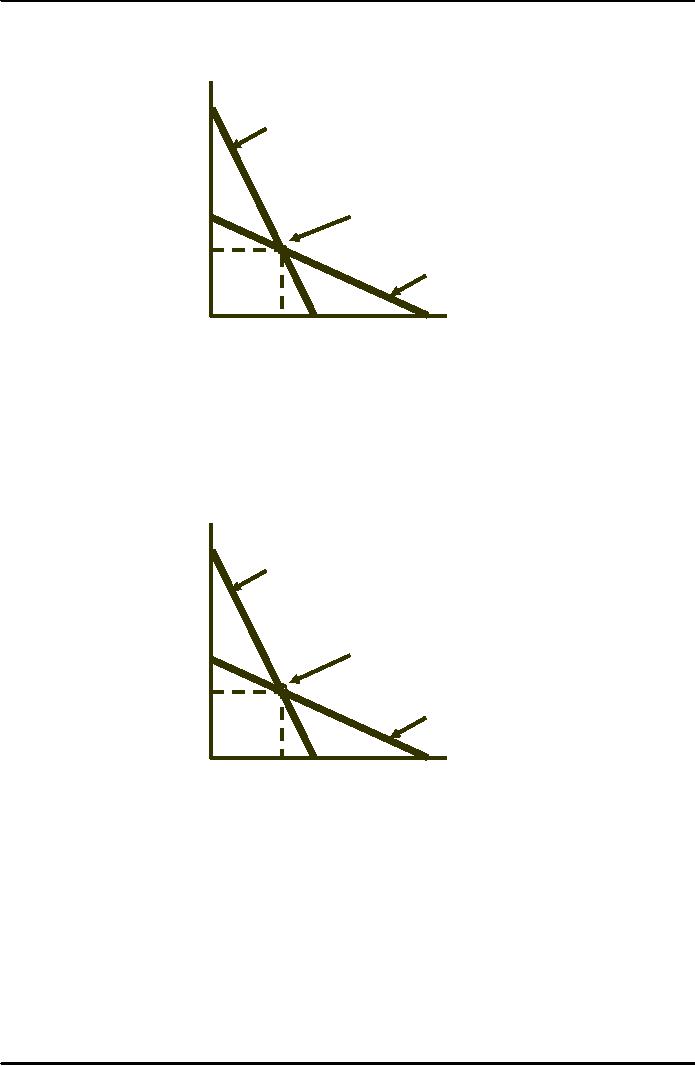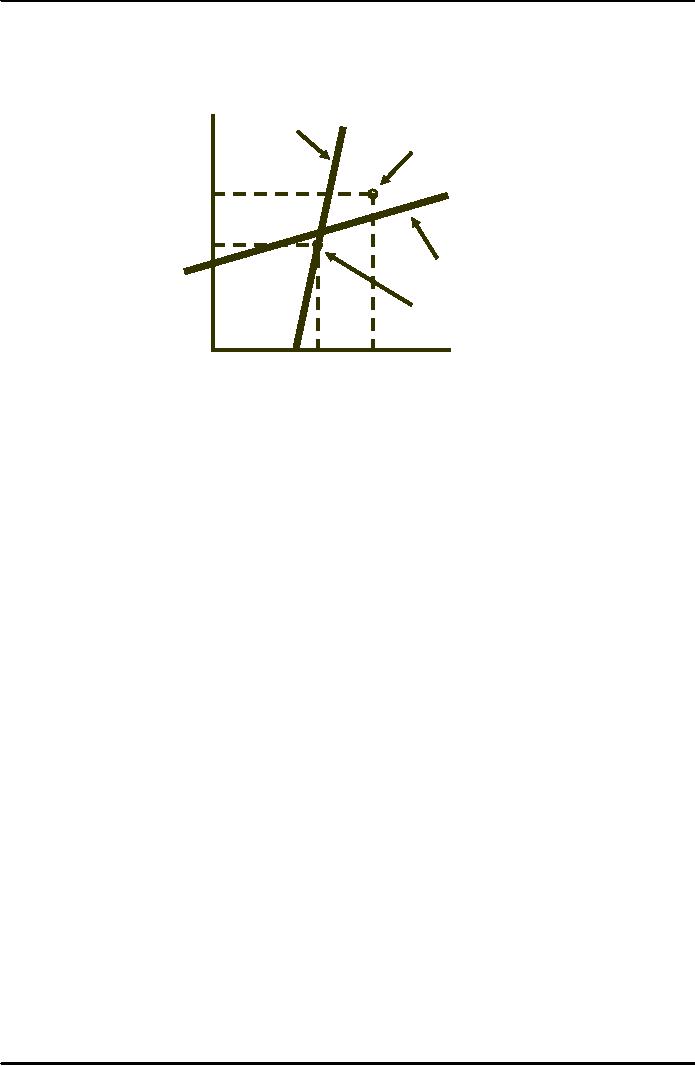 |

Microeconomics
ECO402
VU
Lesson
40
OLIGOPOLY
Characteristics
Small number of
firms
Product
differentiation may or may
not exist
Barriers to
entry
Examples
Automobiles
Steel
Aluminum
Petrochemicals
Electrical
equipment
Computers
The
barriers to entry
are:
Natural
∑
Scale
economies
∑
Patents
∑
Technology
∑
Name
recognition
Strategic
action
∑
Flooding
the market
∑
Controlling an
essential input
Management
Challenges
Strategic
actions
Rival
behavior
Question
What are
the possible rival responses
to a 10% price cut by an
automobile company?
Equilibrium
in an Oligopolistic Market
In perfect
competition, monopoly, and
monopolistic competition the
producers did not
have
to consider a rival's response
when choosing output and
price.
In oligopoly
the producers must consider
the response of competitors
when choosing
output
and price.
Defining
Equilibrium
∑
Firms
doing the best they
can and have no incentive to
change their output or
price
∑
All firms
assume competitors are
taking rival decisions into
account.
Nash
Equilibrium
Each firm is
doing the best it can
given what its competitors
are doing.
The
Cournot Model
Duopoly
∑
Two
firms competing with each
other
∑
Homogenous
good
182

Microeconomics
ECO402
VU
∑
The output
of the other firm is assumed
to be fixed
Firm
1's Output
Decision
If
Firm 1 thinks Firm 2
will
produce
nothing, its demand
P1
D1(0)
curve,
D1(0),
is the market
demand
curve.
If
Firm 1 thinks Firm 2 will
produce
50
units, its demand curve
is
shifted
to the left by this
amount.
If
Firm 1 thinks Firm 2 will
produce
75
units, its demand curve
is
MR1(0)
shifted
to the left by this
amount.
D1(75)
MR1(75)
MC1
What
is the output of Firm
1
MR1(50)
D1(50)
if
Firm 2 produces 100
units?
12.
5
25
Q1
The
Reaction Curve
A firm's
profit-maximizing output is a decreasing
schedule of the expected
output of Firm
2.
Firm
1's reaction curve shows
how much
Q1
it
will produce as a function of
how much
it
thinks Firm 2 will produce.
The x's
100
correspond
to the previous
model.
Firm
2's reaction curve shows
how
much
itwill produce as a function
of
75
how
much
Firm
2's Reaction
Curve
Q*2(Q2)
In
Cournot equilibrium,
50
x
each
firm correctly
Cournot
assumes
how much its
Equilibrium
competitors
will produce
x
and
thereby maximize its
25
Firm
1's Reaction
own
profits.
x
Curve
Q*1(Q2)
x
Q2
25
50
75
100
Questions
1)
If the firms are not
producing at the Cournot
equilibrium, will they
adjust until the
Cournot
equilibrium
is reached?
2)
When is it rational to assume
that its competitor's output
is fixed?
The
linear Demand Curve
An Example of
the Cournot
Equilibrium
∑
Duopoly
Market
demand is P
= 30
- Q
where
Q =
Q1 +
Q2
MC1
= MC2 = 0
183

Microeconomics
ECO402
VU
Duopoly
Example
The
demand curve is P
= 30
-
3
Q
and
Q1
Firm
2's
both
firms have 0 marginal
Reaction
cost.
Curve
Cournot
1
1
Firm
1's
Reaction
Q2
1
1
3
Profit
Maximization with
Collusion
Collusion
Curve
∑
Q1 +
Q2 = 15
Shows all pairs of
output Q
and
Q2 that
maximizes total
profits
1
∑
Q1 =
Q2 = 7.5
Less output and
higher profits than the
Cournot equilibrium
The
demand curve is P
= 30
-
3
Q
and
Q1
Firm
2's
both
firms have 0 marginal
Reaction
Curve
cost.
Cournot
1
E
ilib
i
1
Firm
1's
Reaction
Curve
Q2
1
1
3
0
First
Mover Advantage- The
Stackelberg Model
Assumptions
One firm
can set output
first
MC = 0
Market demand
is P = 30 - Q where Q = total
output
Firm 1 sets
output first and Firm 2
then makes an output
decision
Firm
1
Must consider
the reaction of Firm
2
Firm
2
184

Microeconomics
ECO402
VU
Takes
Firm 1's output as fixed
and therefore determines
output with the
Cournot
reaction
curve
Firm
1
Choose
Q1 so
that:
MR
=
MC,
MC = 0
therefore MR =
0
R1 =
PQ1 =
30Q1 -
Q12 -
Q2Q1
Conclusion
Firm 1's
output is twice as large
as
firm
2's
Firm 1's
profit is twice as large
as
firm
2's
Price
Competition
Competition
in an oligopolistic industry may
occur with price instead of
output.
The
Bertrand Model is used to
illustrate price competition in an
oligopolistic industry
with
homogenous
goods.
Bertrand
Model
Assumptions
∑
Homogenous
good
Market
demand is P = 30 - Q where
Q
= Q1 +
Q2
∑
∑
MC
= $3 for both firms and
MC1 =
MC2 = $3
Assumptions
∑
The Cournot
equilibrium:
P
=
$12
ö
for
both firms = $81
∑
Assume the
firms compete with price,
not quantity.
How will
consumers respond to a price
differential?
∑
The Nash
equilibrium:
P = MC; P = P = $3
1
2
Q = 27;
Q
& Q = 13.5
1
2
ö
=
0
Price
Competition with Differentiated
Products
Market shares
are now determined not
just by prices, but by
differences in the
design,
performance,
and durability of each
firm's product.
Differentiated
Products
Assumptions
∑
Duopoly
∑
FC =
$20
∑
VC = 0
Firm
1's demand is Q1 = 12 - 2P1
+ P2
∑
∑
Firm 2's
demand is Q2
= 12 - 2P1 + P1
P
and
P2 are prices firms 1
and 2 charge
respectively
1
185

Microeconomics
ECO402
VU
Q
and
Q2 are
the resulting quantities
they sell
1
Nash
Equilibrium in Prices
P1
Firm
2's Reaction
Curve
Collusive
Equilibrium
$6
$4
Firm
1's Reaction
Curve
Nash
Equilibrium
P2
$6
$4
186
Table of Contents:
- ECONOMICS:Themes of Microeconomics, Theories and Models
- Economics: Another Perspective, Factors of Production
- REAL VERSUS NOMINAL PRICES:SUPPLY AND DEMAND, The Demand Curve
- Changes in Market Equilibrium:Market for College Education
- Elasticities of supply and demand:The Demand for Gasoline
- Consumer Behavior:Consumer Preferences, Indifference curves
- CONSUMER PREFERENCES:Budget Constraints, Consumer Choice
- Note it is repeated:Consumer Preferences, Revealed Preferences
- MARGINAL UTILITY AND CONSUMER CHOICE:COST-OF-LIVING INDEXES
- Review of Consumer Equilibrium:INDIVIDUAL DEMAND, An Inferior Good
- Income & Substitution Effects:Determining the Market Demand Curve
- The Aggregate Demand For Wheat:NETWORK EXTERNALITIES
- Describing Risk:Unequal Probability Outcomes
- PREFERENCES TOWARD RISK:Risk Premium, Indifference Curve
- PREFERENCES TOWARD RISK:Reducing Risk, The Demand for Risky Assets
- The Technology of Production:Production Function for Food
- Production with Two Variable Inputs:Returns to Scale
- Measuring Cost: Which Costs Matter?:Cost in the Short Run
- A Firmís Short-Run Costs ($):The Effect of Effluent Fees on Firmsí Input Choices
- Cost in the Long Run:Long-Run Cost with Economies & Diseconomies of Scale
- Production with Two Outputs--Economies of Scope:Cubic Cost Function
- Perfectly Competitive Markets:Choosing Output in Short Run
- A Competitive Firm Incurring Losses:Industry Supply in Short Run
- Elasticity of Market Supply:Producer Surplus for a Market
- Elasticity of Market Supply:Long-Run Competitive Equilibrium
- Elasticity of Market Supply:The Industryís Long-Run Supply Curve
- Elasticity of Market Supply:Welfare loss if price is held below market-clearing level
- Price Supports:Supply Restrictions, Import Quotas and Tariffs
- The Sugar Quota:The Impact of a Tax or Subsidy, Subsidy
- Perfect Competition:Total, Marginal, and Average Revenue
- Perfect Competition:Effect of Excise Tax on Monopolist
- Monopoly:Elasticity of Demand and Price Markup, Sources of Monopoly Power
- The Social Costs of Monopoly Power:Price Regulation, Monopsony
- Monopsony Power:Pricing With Market Power, Capturing Consumer Surplus
- Monopsony Power:THE ECONOMICS OF COUPONS AND REBATES
- Airline Fares:Elasticities of Demand for Air Travel, The Two-Part Tariff
- Bundling:Consumption Decisions When Products are Bundled
- Bundling:Mixed Versus Pure Bundling, Effects of Advertising
- MONOPOLISTIC COMPETITION:Monopolistic Competition in the Market for Colas and Coffee
- OLIGOPOLY:Duopoly Example, Price Competition
- Competition Versus Collusion:The Prisonersí Dilemma, Implications of the Prisoners
- COMPETITIVE FACTOR MARKETS:Marginal Revenue Product
- Competitive Factor Markets:The Demand for Jet Fuel
- Equilibrium in a Competitive Factor Market:Labor Market Equilibrium
- Factor Markets with Monopoly Power:Monopoly Power of Sellers of Labor